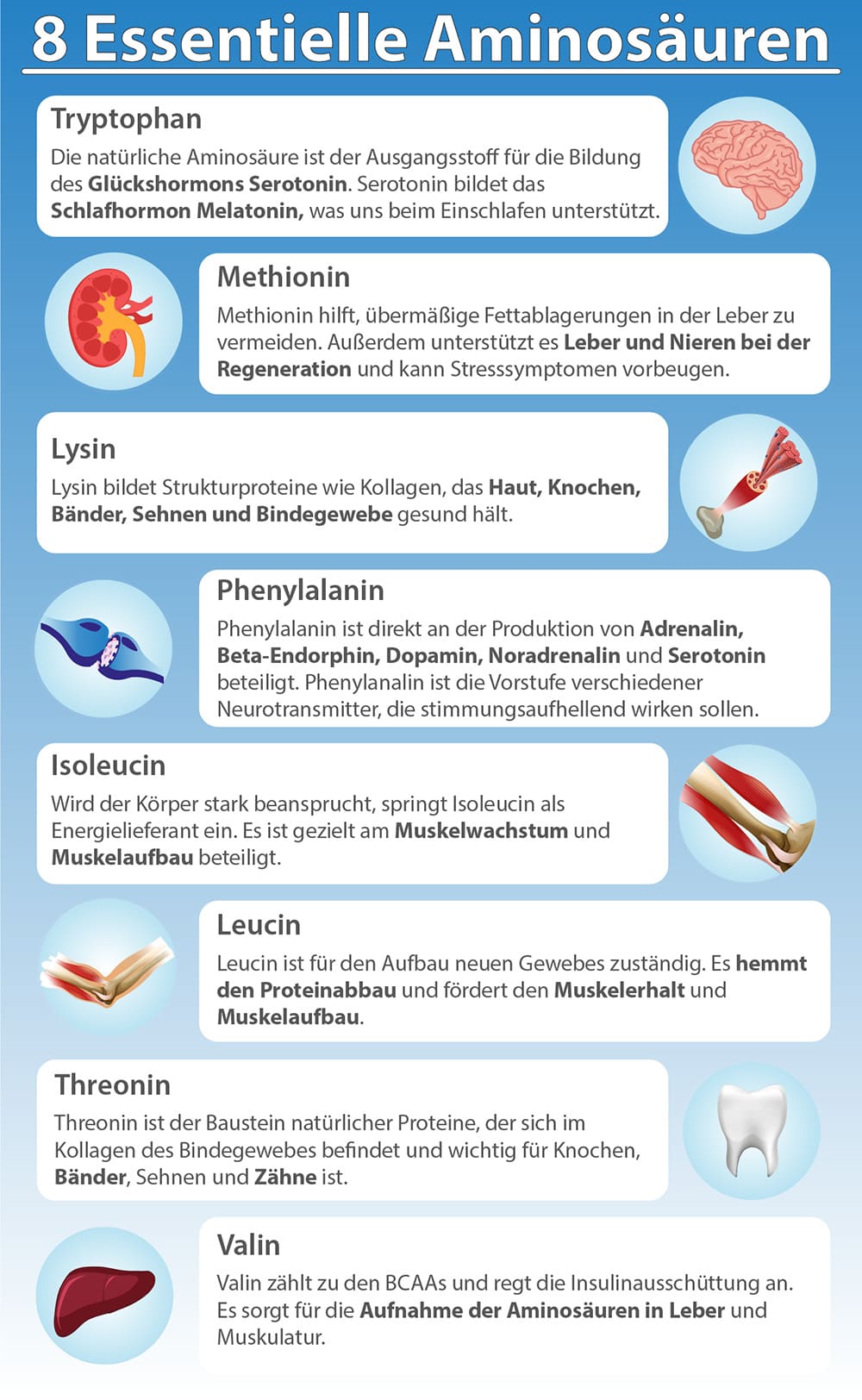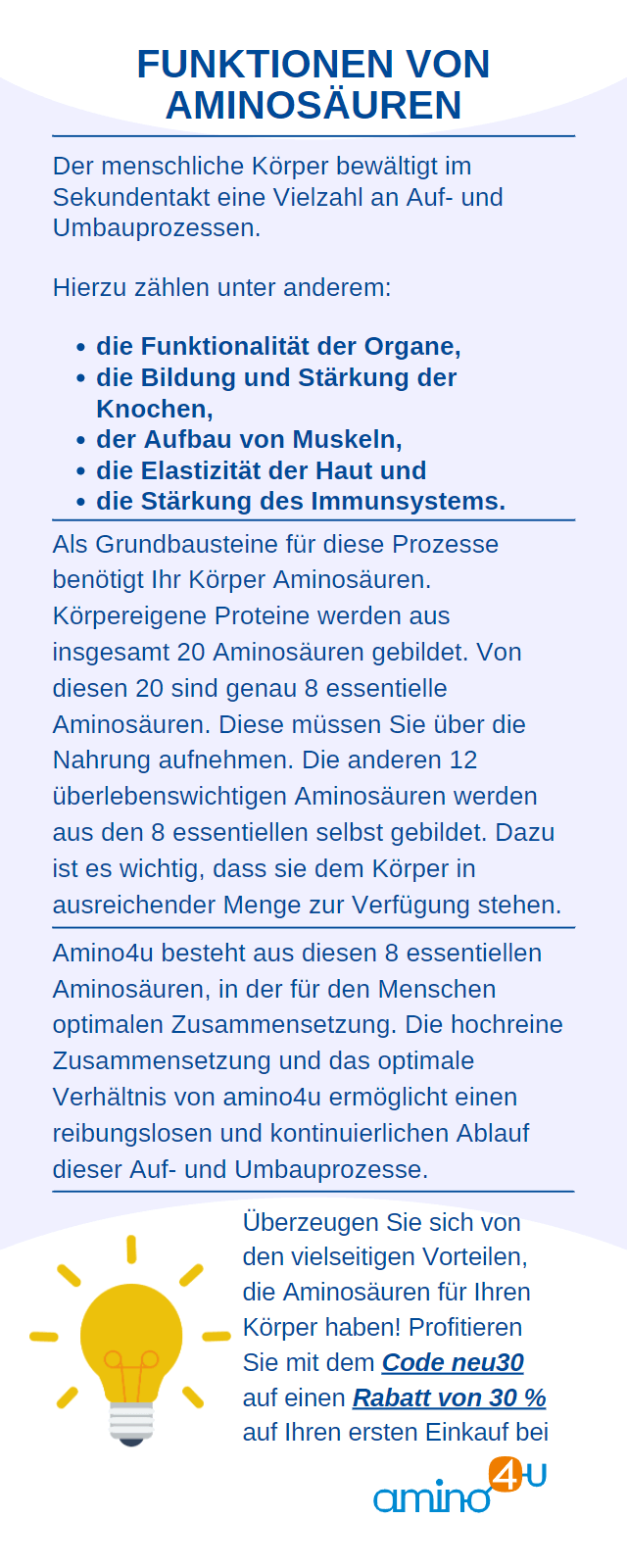Have you ever looked into the topic of amino acids and protein? You may know essential and semi-essential amino acids. You may have already asked yourself what the classification as essential and semi-essential means in this context. Or what the distinction between the different amino acids can mean for your nutrition and supply. We have compiled the most important information on the topic for you.
Amino acids, their functions and different types
Amino acids are also known as protein building blocks. People often simply talk about aminos. By linking them together, proteins and peptides of different lengths are formed. Protein is generally synonymous with protein. You probably know protein as one of the
macronutrients alongside fats and carbohydrates.
Amino acids, proteins and the protein building blocks are the group of substances in the body that are subject to constant conversion processes. That's why the protein building blocks also have many functions in the human organism.
 You can find some of them here:
You can find some of them here: She…
- As building materials, they form the basis of every physical tissue.
- serve as starting materials for the formation of enzymes - important substances that promote reactions between other substances.
- are the basis for the formation of hormones .
- convert into neurotransmitters and messenger substances.
There is therefore hardly a function in the human organism that is not dependent in some way on certain protein building blocks.
The different amino acids
Some aminos can be produced from other substances in the human organism - often other protein building blocks. Others need to be supplied steadily in the diet. The latter group is made up of the indispensable (i.e. non-essential) protein building blocks - so-called
non-essential amino acids . There are also protein building blocks that our body cannot produce itself in certain situations or at a certain age. So sometimes they are essential and sometimes dispensable. That's why they get the prefix "
semi ", which describes the intermediate state well. We also speak of partially dispensable or
semi-essential protein building blocks .
What are essential amino acids?
Essential amino acids are:
- Lysine
- Valine
- Leucine
- Isoleucine
- Phenylanaline
- Tryptophan
- Methionine
- Threonine.
Why are
amino acids essential ? Because we have to get them through food. As a rule, only animal foods contain all representatives of this group in the right proportion and in the right proportion to one another. Vegetarians and even more so vegans can therefore have challenges getting enough of the essential building blocks. If you are vegan, you should pay particular attention to the composition of your food ingredients. The
need for protein in general and also for protein building blocks increases in certain life situations, such as with age. That's why some nutrition experts now recommend additional intake, especially of the essential protein building blocks, through dietary supplements.
 The semi-essential amino building blocks
The semi-essential amino building blocks
This group is made up of the protein building blocks
- Arginine, forms new amino acids
- Asparagine supports the body in cell renewal and is important for muscle metabolism
- Cysteine, partly responsible for the development of the nervous system and normal heart function
- Glutamine supports the immune system and is a source of energy
- Glycine is involved in liver detoxification and stabilizes the immune system
- Proline, forms collagen and supports connective tissue and bones
- Tyrosine, supports normal thyroid function
educated. For arginine, asparagine, glycine and proline, there is no consistent assessment in the literature as to whether they are semi-essential. However, the majority of experts today also consider these 4 to be
semi-essential amino acids and not dispensable overall. Histidine is also sometimes included in this group. This building block cannot yet be produced by the body itself, especially in newborns, during the first days of life.
The amino acid pattern
The essential protein building blocks are also considered important for the human organism because they are
proteinogenic (i.e. produce protein).
Proteinogenic amino acids are the building blocks of our body. Over 99% of the 8 essential representatives of the group are converted into the body's own protein. The American scientist Professor Dr. Luca-Moretti concluded that these eight building blocks form the human amino acid pattern. He believes that every mammal forms its own characteristic pattern of particularly usable protein building blocks. The formation of the body's own protein can only be ensured if these building blocks are available to the organism at the same time and in the right proportions to one another.
What is the significance of the semi-essential protein building blocks?
You may have concluded from the article so far that
semi-essential amino acids are less important for you. You may now be of the opinion that these building blocks are less important than the essential ones. The term “
conditionally dispensable ” only refers to the fact that you don’t necessarily have to get these building blocks with your food. It says little about the important and sometimes vital tasks that this group of protein building blocks fulfills in your body.
 Two concrete examples:
Two concrete examples:
-
Arginine
The amino acid arginine is involved in the so-called NO cycle (“
nitric oxide cycle ”) in the human body. Among other things, it ensures that nitrogen is formed. Nitrogen is closely linked to vascular health. Arginine can contribute to vasodilatation. The protein building block can therefore, among other things,
- the blood pressure,
- the male erection,
- muscle building,
- the performance of the muscles and their regeneration
have an influence.
-
Tyrosine
The amino acid tyrosine is the basis for the formation of vital messenger substances such as dopamine, DOPA and thyroxine. Thyroxine is the starting material for the formation of the
thyroid hormone T3 . Dopamine serves a very important function as an excitatory neurotransmitter in the
central nervous system . Among other things, it also affects our mood.

It is believed that this substance influences the increase in drive and internal motivation in people. DOPA, in turn, forms the basis of other
neurotransmitters such as adrenaline, norepinephrine and dopamine. Serious illnesses such as B. Parkinson's disease is associated with a dopamine deficiency. This can show us what importance the messenger substances mentioned have for our health.
Can it make sense to also supplement semi-essential amino acids?
Amino acid nutritional supplements with essential protein building blocks are now more commonly used by
orthomolecular physicians
- athletes,
- older people and
- recommended for certain illnesses.
What about
semi-essential amino acids ? Can you also benefit from an additional supply of these protein building blocks - for example in an appropriately composed amino acid solution? To answer this, let's look at
two assumptions : In order for us to have a sufficient supply of semi-essential protein building blocks at all times, we would have to
- All other important raw materials for the formation of these building blocks are available to our body at any time and in sufficient quantities.
- we assume that our need for semi-essential aminos does not change in our lives.
We cannot guarantee either. Maybe you suffer from high blood pressure as you get older. An additional supply of arginine could help control your blood pressure after consultation with your doctor. This does not mean that this
semi-essential amino acid becomes essential. It is said that more arginine can support you in this health situation. Arginine is also found in various foods. The protein building block is also synthesized by the body from the substances ornithine and aspartate. Users of corresponding nutritional supplements report that tyrosine, taken in an
amino acid solution , gives them a balanced mood and more internal motivation. Tyrosine is formed from the essential protein building block phenylalanine. At this point the connection between the semi- and essential aminos may become clear to you. If there is already a lack of essential protein building blocks, this can hinder the formation of some semi-essential building blocks. The higher our need for protein and protein building blocks, the more difficult it is to provide us with the right amount of semi-essential aminos. We need more protein due to, among other things, stress, physical strain and sport or our age. The
interaction of the various substances is very complex.

Conclusion: Supplementing with semi-essential protein building blocks can make sense
If you want to supplement your diet with an amino acid solution, be sure to also think about the semi-essential protein building blocks. Essential and partially dispensable aminos have
different functions in our body and are also connected to each other. The essential aminos are partly the starting point for the formation of the semi-essential representatives. If our need for these protein building blocks increases in certain life situations, they can quickly become indispensable protein building blocks. Basically, all
amino acids are important for
vital processes in the human organism. Due to their special functions, one or two semi-essential amino acids can also offer you valuable support for your health and well-being. That's exactly why we developed
amino4u .
 You can find some of them here: She…
You can find some of them here: She…
 The semi-essential amino building blocks
The semi-essential amino building blocks Two concrete examples:
Two concrete examples:
 It is believed that this substance influences the increase in drive and internal motivation in people. DOPA, in turn, forms the basis of other neurotransmitters such as adrenaline, norepinephrine and dopamine. Serious illnesses such as B. Parkinson's disease is associated with a dopamine deficiency. This can show us what importance the messenger substances mentioned have for our health.
It is believed that this substance influences the increase in drive and internal motivation in people. DOPA, in turn, forms the basis of other neurotransmitters such as adrenaline, norepinephrine and dopamine. Serious illnesses such as B. Parkinson's disease is associated with a dopamine deficiency. This can show us what importance the messenger substances mentioned have for our health.




